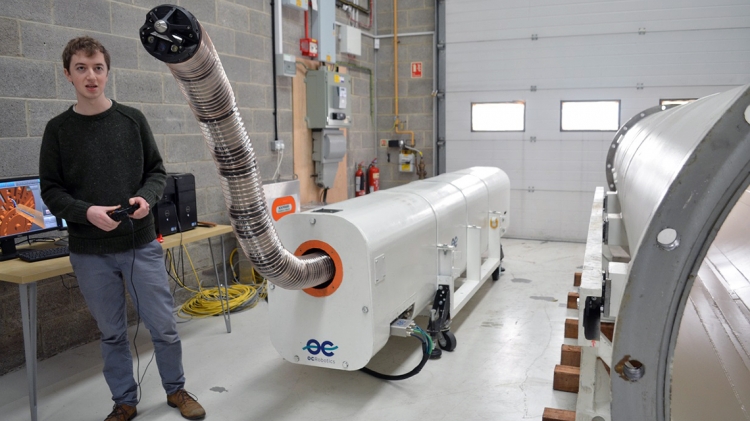New and emerging technologies are making decommissioning and remediation more cost effective, faster and safer. From planning to execution and control, the use of new technologies is on the rise.
This week's International Conference on Advancing the Global Implementation of Decommissioning and Environmental Remediation Programmes, in Madrid, Spain, covers important issues in these two fields. The latest issue of the IAEA Bulletin also deals with this topic. See the full edition here.
Lasers and drones for better planning
Before starting decommissioning or environmental remediation, experts need to plan each step of the process, and to do that, they first need a clear idea of the characteristics of the structure and the level of radiation that they can expect to encounter.
While characterization for planning purposes can be done using manual approaches, such as drawing up blueprints and taking measurements and photos, laser scanning technologies are now allowing decommissioning teams to more quickly and accurately map out the physical characteristics of a facility’s structures, systems and components. This is complemented by highly sensitive measurements taken with high-tech devices, such as remotely operated gamma cameras that can precisely and efficiently measure the radiological characteristics of the facility, including the amount and type of radiation. Similar measurements are needed once the contamination has been removed, to verify that any residual radiation levels are indeed insignificant.
For environmental remediation specialists, understanding the nuanced dimensions of how a site’s environment — and the contaminants within it — behave over time is increasingly important. New tools such as drones equipped with sensors allow specialists to remotely evaluate the site’s surface and, when combined with data collected on the ground, can help determine the nature, concentration and distribution of contaminants in the soil. This provides a high-resolution characterization of the site’s physical and radiological characteristics, as well as of the underlying environmental behaviour and dynamics.
In both cases, once the data has been collected, state-of-the-art 3D modelling software can generate highly detailed reproductions of the facility or site and an overlay map of its radiation levels. Modelling software can also be used in environmental remediation for simulating the behaviour of pollutants in the environment, a key step in the selection and implementation of safe, sustainable and cost effective approaches for remediation and long term monitoring and management of a site.
Humans and robots
Nuclear facilities are full of nooks and crannies that can be hard to reach and, in some areas, highly radioactive and dangerous for workers to enter. Robots are offering new ways to handle these challenges.
“There are some parts of these facilities where workers simply cannot go, either because they are too small and narrow or too radioactive and dangerous. That’s where robotics can make a difference,” said Vladimir Michal, Team Leader for Decommissioning and Environmental Remediation at the IAEA. “Remotely controlled tools can be used to measure radioactivity, decontaminate nuclear power plants and eventually to segment and handle the plant components, avoiding the risk a human being would face.”
As technology advances, robots have become smaller, more sophisticated and refined, allowing them to operate in a variety of terrains and in extreme environments. Multifunctional robotic arms, for example, can be operated remotely by workers and equipped with tools such as laser cutters to allow dismantling of hard-to-reach pipes and reactor components, among others.
Remotely controlled cutting tools may also operate underwater, with operators located close by, protected by the natural shielding water provides against radiation. By breaking down radioactive components underwater, these robots can help to protect workers and prevent the emission of airborne particles.
Innovative nature
Innovation is not always about creating complex new gadgets. ‘Engineering with nature’ is an emerging concept in environmental remediation. In some situations the optimum remedial solution may not be the one involving costly tools and chemical operations.
“Letting nature run its course may, in some cases, be the best course of action, but it requires highly detailed understanding and prediction of the relevant environmental processes. It is only more recently that computational tools, techniques for characterization and monitoring became powerful enough to enhance confidence in the use of this approach,” said Horst Monken-Fernandes, an environmental remediation specialist at the IAEA.
Nanoscale remediation, or nanoremediation, is a new technique that makes use of tiny man-made structures known as nanoparticles to rapidly and efficiently reduce contaminant concentrations in soil and groundwater. These particles, which are about 100 000 times smaller than the width of a single hair, have excellent storage, transportation, penetration and distribution capabilities. They can be injected into the subsurface of a contaminated source to degrade or immobilize the contaminant. They can also be used to trap contaminants through nanostructures that behave like a molecular sieve. This technique has the potential to be more cost-effective than traditional techniques, such as excavation in reaching the clean-up goals in environmental remediation.
A whole new world
Innovation opens the door to new possibilities, but also imposes new training requirements. One solution to address this is virtual reality. The 3D world offers an opportunity for practitioners to get first-hand experience in each step of the decommissioning and environmental remediation process. This can include, among other things, specification of the cutting sequence to be followed, the levels of exposure to radiation that workers may face, the most efficient options for component removal and packaging of the segmented waste pieces and potential safety hazards.
While the potential benefits of new technologies and innovations are vast, it often takes years to scale these up for wider use, particularly in countries where budgets and resources are limited. The IAEA’s support helps countries get the information, experience and training they need.
“The vision of the IAEA is to assist Member States in developing and maintaining their capacity to manage decommissioning and remediation projects in a timely, safe and cost-effective manner,” Michal said.
Remotely controlled tools can be used to measure radioactivity, decontaminate nuclear power plants and eventually to segment and handle the plant components, avoiding the risk a human being would face.







